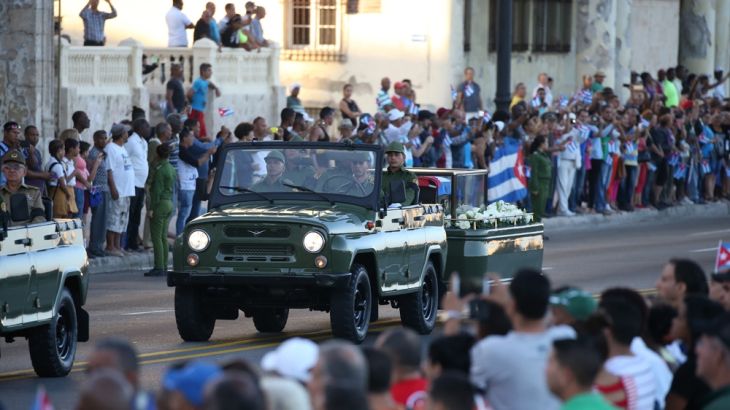Fidel Castro’s ashes begin journey across Cuba
Remains of the late Cuban leader will travel more than 800-km, retracing in reverse Castro’s revolutionary tour.

Fidel Castro’s ashes began a four-day journey across Cuba from Havana to their final resting place in the eastern city of Santiago.
A small, Cuban-flag covered cedar coffin containing the remains of the 90-year-old leader was taken out of Cuba’s Defence Ministry just after 7am on Wednesday and placed into a flower-bedecked trailer pulled by a green military vehicle for the more than 800-km procession.
Keep reading
list of 4 itemsWhat’s going wrong in Cuba? | Start Here
Cuba has a new leader and it’s not a Castro
A new era in Cuba?
The crowds at the rally and along Wednesday’s procession route were a mix of people attending on their own and groups of Cubans organised by government workplaces, where attendance was not strictly obligatory, but with strong pressure to attend.
The ashes will be interred on Sunday, ending the nine-day mourning period for the man who ruled the country for nearly 50 years.
The route traces in reverse the victory tour Castro and his bearded rebels took after overthrowing the forces of strongman Fulgencio Batista in 1959.
Outside Havana, the caravan will pass through rural communities significantly changed by social and economic reforms he adopted.
Many residents now have access to healthcare and education. But many of those towns are also in a prolonged economic collapse, the country’s once-dominant sugar industry decimated, the sugar mills and plantations gone.
![The caravan from Havana will pass through rural communities significantly changed by social and economic reforms he adopted [Rodrigo Arangua/AFP]](/wp-content/uploads/2016/11/48fc0cfe404c4b3899cdf88e219f60ad_18.jpeg)
Many had attended a massive rally on Tuesday at Havana’s Revolution Plaza, where the presidents of Cuba, Mexico, Ecuador, Bolivia, Venezuela and South Africa – along with leaders of a host of smaller nations – offered speeches paying tribute to Castro, who died on Friday night.
In Havana and across the Caribbean island, people signed condolence books and an oath of loyalty to Castro’s sweeping May 2000 proclamation of the Cuban revolution as an unending battle for socialism, nationalism, and a role for the island on the world stage.
Cuban leader Fidel Castro’s mixed legacy
Inside the memorial, thousands walked through three rooms with near-identical displays featuring the 1962 Alberto Korda photograph of the young Castro in the Sierra Maestra mountains, bouquets of white flowers, and an array of Castro’s medals against a black backdrop, framed by honour guards of soldiers and children in school uniforms.
The ashes did not appear to be on display.
Signs read: “The Cuban Communist Party is the only legitimate heir of the legacy and authority of the commander-in-chief of the Cuban Revolution, comrade Fidel Castro.”
The scene was played out on a smaller scale at countless places across the country as the government urged Cubans to reaffirm their belief in a socialist, single-party system that in recent years has struggled to maintain the fervour that was widespread at the triumph of the 1959 revolution.
|
|